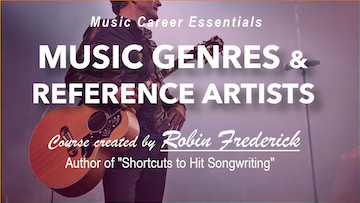
Remember when you learned to ride your first bicycle? It wasn’t easy. You fell down a lot, but you kept trying. At first you needed someone to hold on, keeping you steady. Then you used training wheels to help you stay upright as you pedaled. Then, finally, you were able to ride on your own. You had found that complicated thing called balance. After that, it was a breeze! The process of writing songs is a lot like riding a bike. It’s all about finding a balance!
=> Balance Melody, Chords, Lyrics
Writing a song that listeners will love involves finding a good balance between melody, lyrics, and chords. If you have a busy lyric with a lot of words and images then writing a melody that’s easy for listeners to follow might give your song more appeal. On the other hand, if you have a complicated melody with a lot of rhythmic interest and interval jumps, then keeping your chord progression simple might be a good idea. Try the chord progressions on this page to get things going.
When there are too many things demanding their attention, listeners don’t know what to focus on and that can be frustrating. If they’re feeling confused or overwhelmed, they’re likely to tune out.
A good rule of thumb: As the complexity of one of your song elements goes up – lyrics, melody, or chords – consider organizing the other elements in easy-to-follow patterns or using more repetition.
We all love to write those beautiful, poetic lines but they can sometimes be hard for listeners to understand.
=> Balance within each song element
We all love to write beautiful, poetic lines but they can sometimes be hard for listeners to understand. So, try to mix in a few conversational lines that come right out and say what you want the listener to know.
If you don’t feel comfortable interweaving poetic and conversational within a single song section, consider making your verse the evocative, poetic section, then come straight to the point in your chorus. Let the singer come right out and say what he or she feels so the listener knows what’s going on.
The same idea can be applied to melody. If you have a verse with a fast-paced, complicated melody, consider writing a chorus with a little breathing room. Stretch out the melody notes in the chorus and use fewer notes per beat. use a little more repetition or a simple melodic pattern. Give the listener a chance to absorb what’s happening before plunging into another verse.
=> Study the balance in your genre
Each genre has a balance of melody, lyrics, and chords that gives it a characteristic sound. For instance, the Pop genre tends to have a lot of melodic interest. Verse, pre-chorus, and chorus all have different melodies with changing dynamics and rhythmic twists. Pop lyrics maintain a balance by staying focused on a single emotional situation that’s clearly defined in the chorus.
The Country genre, on the other hand, relies on lyric stories with more physical detail and development than Pop. Listeners need to pay attention to the lyric in order to get the full impact. As a result, Country melodies tend to be a little less complex than in the Pop field.
This doesn’t mean you can write a boring melody, ever! You’ll still need to keep your listeners interested with strong melody patterns and plenty of contrast between sections. But you might want to use fewer melodic twists than you would in the Pop genre.
=> Balance craft and inspiration
Balance is also an essential part of your approach to songwriting as a whole. Finding a balance between inspiration and song craft can help you express your deepest thoughts and feelings and in a way that listeners can understand and respond to.
Inspiration can be a very personal thing, sometimes giving you lines that may mean something to you but not to your listener.
Inspiration is the heart of your songwriting. It’s what guides you, tells you what’s important, and delivers that brilliant line out of the blue. But inspiration can be a very personal thing, sometimes giving you lines that may mean something to you but not to your listener. If you balance inspiration with an equal amount of song craft, you’ll end up communicating more effectively, surrounding those inspired gems with lines that support them and keep the listener involved.
Making the best use of inspiration.
=> Training wheels help you keep your balance
The best songwriting “training wheels” are hit songs. These songs already have good balance, the kind that listeners are comfortable with. Get comfortable with that balance by learning how to play and sing recent hit songs that you like. (You can find a current list of the Top 100 songs available for free on Billboard.com.)
Notice the balance between lyrics, melody, and chords. How is the melody organized? How simple or complicated is the chord progression? (Most are pretty simple.) Which melody lines are repeated and how many times? When do the lyrics simply repeat and when do they demand attention? Learn to play and sing one recent hit song every week. You’ll be getting a better feel for song balance every time you do.
Read my Song Guides for a closer look inside today’s hit songs.
=> It takes practice to find your balance
Just like riding a bicycle, it takes practice to learn what good balance feels like. When you learn a new melody or lyric writing technique, it may take some practice before you feel confident using it. There’ll be some wobbles and falls and a few scraped knees. But, just like you did when you were a kid, get back up on your bike and try again. Once you get the feel, you’ll be flying down the sidewalk with the wind in your hair in no time! Best of all, like riding a bike, once you learn what balance feels like, you never forget!
by Robin Frederick


